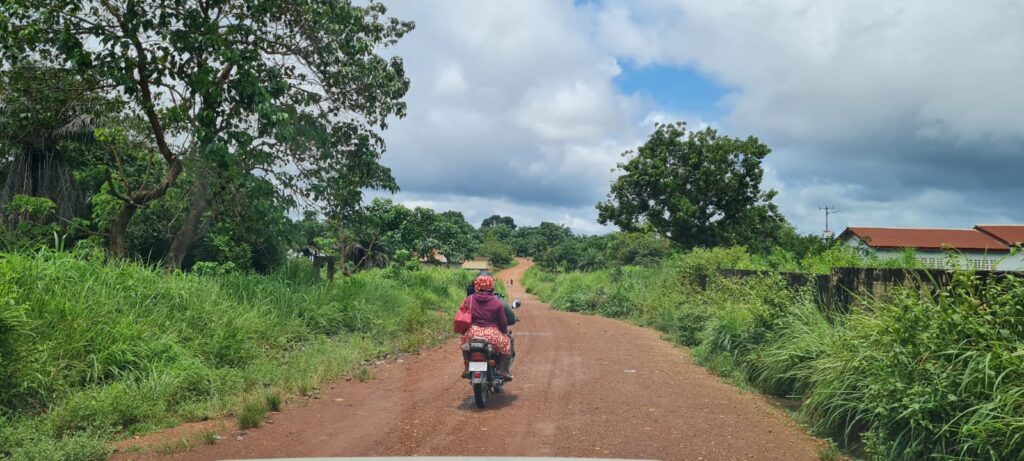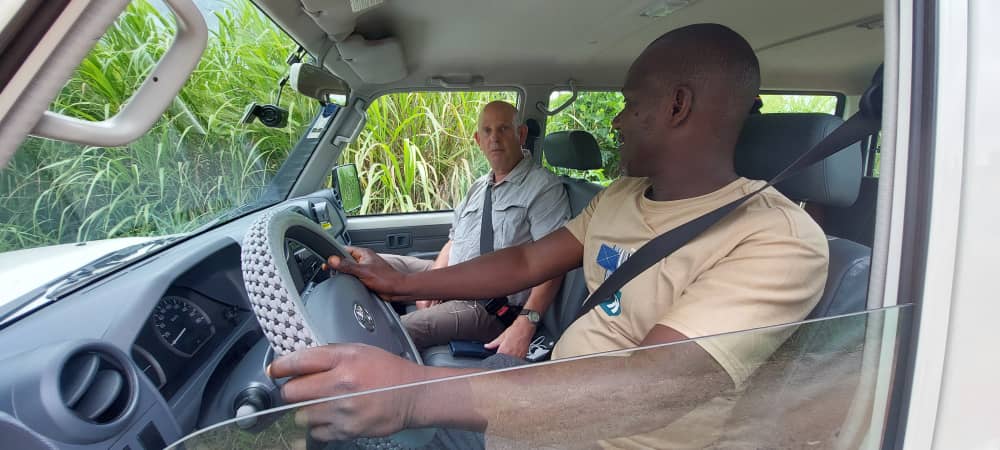In September 2024, we provided an advanced training session for several drivers based in Sierra Leone who work for an international business involved in the extraction of diamonds. Here is a first-hand account from our tutor, Chris Potten, who provided this training:
This was my second driver training job in Sierra Leone, the first being many years ago in 2012. The airport had been updated, with the new one having opened around 12 months ago and is a great improvement on the original. Other improvements were somewhat limited. The road infrastructure has improved on major routes; the remainder are dirt roads through villages and jungle areas ravaged by heavy rains that continue for around six months every year.
The Location:
Sierra Leone is situated in tropical Africa, on the west coast, and almost on the equator. It is incredibly green and lush – a very beautiful country. However it’s also one of the poorest on the planet, and it’s clear to see the poverty all around. Many people live in huts, some clay/stone built, no services or utilities to these buildings for the most part, and power is mostly created by diesel generators owned by a few. There are services to other buildings and offices, so my accommodation in the town of Koidu was well served, apart from the inevitable power cuts as a result of heavy rain and thunderstorms, which occurred each evening.
4×4 Training:
I have delivered similar training, 4×4 vehicles on and off-road, to companies in other African countries over the past 12 years or so, including Kenya, Tanzania, Ghana, Guinea, etc. These days I don’t suffer from any ‘culture shock’, but it is still quite shocking to see how some people have to live. The country had to endure a bloody civil war between 1992 and 2002, which was devastating for the population. Currently, things are stable.
Freetown to Koidu:
I was collected at Freetown airport hotel on the morning of 1 September, then conveyed to Koidu, a road journey of around 5 hours, in a Toyota 76 Landcruiser Station wagon. These vehicles are very popular in Africa, having 4-wheel drive systems, including front and rear differential locks. My brief was to assess and coach the driver taking me on the reasonably long journey. He was reasonably good, but a few issues arose. These were followed up when the same guy, Ibrahim, did his actual training day during the following days.

Main training location: Koidu:
The area of operation for me and the drivers was around Koidu, using populated areas, with tarmac roads, as well as dirt roads through villages which comprised open-fronted sheds mainly, with adults and children from the poorest of the population living in relative squalor, usually with various animals wandering around and in and out of their dwellings. These tracks were usually filled with holes and gulleys formed by running water from heavy rain for a lot of the year. The area seemed quite clay-laden and very slippery, and areas of soft mud were common. These were good areas to train in the correct uses of the 4×4 systems. Most drivers had no experience of using low-range gears, didn’t know which gears they should use and why, and didn’t understand what a differential lock does. Fortunately, all seemed wise enough to use the 2-wheel drive on the tarmac, but it was often assumed that 4-wheel drive was only needed when stuck or when the area was slippery or difficult to get through. On one occasion a Toyota Hilux pickup was used, a basic 4×4 without differential locks.
The drivers were primarily there to convey line managers and some ex-pats to the mine areas. This was never a matter of huge urgency, so the best advice is always to assess the route and ground ahead before committing and always ensure you can get out again if you enter a difficult area.


As with most driver training, a theory presentation was considered appropriate, and all drivers and their line managers attended this (including those who don’t drive, which was most of them), and found it useful and resulted in quite a few questions due to much of it being new to them. The line managers were also to travel with us in the vehicles to see for themselves what training was given, how coaching was delivered and whether the drivers responded favourably, which, fortunately, they all did. The managers were extremely interested in all aspects and involved themselves, which was ideal. They really took on board the theoretical side and will no doubt be able to monitor whether the drivers maintain standards or improve through practice over the subsequent period.
Vehicle checks:
Initial vehicle checks threw up a few issues: tyre pressures at 45/52 psi on one vehicle and drivers wanting to unscrew the radiator cap to check the radiator water. The expansion tank/coolant reservoir seemed to have passed some of them by. These checks are taken seriously and all the drivers were keen to do them correctly. Although all-terrain tyres were used, they were somewhat lacking in the worst of the areas. They carried little equipment for self-recovery, so various potential measures have been suggested.
Training underway:
Over the several days, the drivers were coached in on-road and off-road techniques, mainly defensive, but a few advanced ones were introduced. They particularly liked the concept of using positioning to obtain earlier vision on approaches to, and through bends, along with gear timing and the use of acceleration sense. Some of the expat bosses were rather concerned with lack of progress by some of the drivers.
The signage for speed limits is fairly clear, but out of towns there is an occasional sign identical to the UK National Speed Limit sign, which no one seemed to know the meaning of. Other than that, most of the limits were 50 kph, mainly for towns and villages, or 80 kph when leaving those areas. The Police do not check speeds, the only time they consider it would be in the case of a serious or fatal crash, when various (probably old school) markings and measurements would determine a possible speed. There are no cameras, of course, and most of the Police are occupied at the various Check-Points on most routes.

The local taxis:
One of the main factors in road safety is the extensive use of motorcycles. Males of varying ages obtain small or moderately powered motorbikes, and use them as taxis for the locals. The line managers told me this was their only means of getting to and from work, and is accepted as the norm.
They ride on the wrong side of the road, cut across the paths of anyone and everyone and usually carry at least two passengers, but commonly three, sometimes with a baby being held by one of them, or a goat or chickens too.
They use them on the dirt tracks too, including through mud and up and down very slippery and challenging routes; usually the passengers get off for a few minutes to allow the rider to walk the bike through the worst of the terrain. They do surprisingly well, but I wouldn’t want to try it! I think the statistics (apparently) speak for themselves, especially as the passengers are merely dressed in normal clothes, with no protection whatsoever.

In conclusion:
The drivers were all really friendly and wanted to learn as much as they could.
One of the drivers took me back to the airport on my final day, along with one of the managers who wanted to go on to Freetown itself. As I was about to get out of the vehicle, the young driver said, ‘Thank you, I’ve learned so much, we shall really miss you’.
I couldn’t ask for a better conclusion than that!
Chris Potten – Drivers Domain UK tutor.

